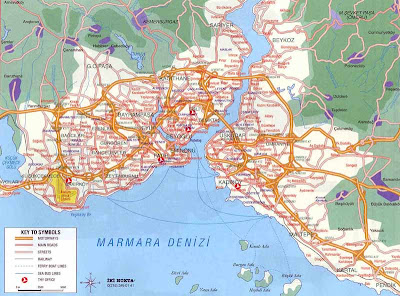Down below you can probably find a map of Istanbul that you`ll find useful.
Istanbul is a gigantic metropolis that is both the largest city in Turkey, as well as an ancient historical city commonly referred to by its historical names Byzantium and Constantinople. The Istanbul metropolitan area has 13.26 million people, and if we include the Asian sections of the city, it is the third largest metropolitan area in Europe.
The city is bisected by the Bosphorus Strait, with the Western portion lying in Europe and the Eastern portion lying in Asia. Most of the places of historical and cultural interest lie on the European side while the Asian side is more residential and modern shopping districts.
Istanbul may not match your preconceptions of a Mediterranean or Middle Eastern city, with relatively cool to mild weather. Summers are warm, but with temperatures typically in the 20s, making truly hot weather a rarity. Winters are rather cold and frost and even snow are not uncommon. Temperatures in the heart of winter average around 4 degrees C, with temperatures commonly falling below freezing at night and in the early morning. Fall and Spring and mild and fairly wet. Don`t expect to see rolling sand dunes and camels in downtown Istanbul. Even if you consider Istanbul part of the Middle East (many Turks don`t), you would have to visit an entirely different part of the region to experience that.



Hopefully one of the Istanbul map files up above was what you were looking for. Be sure to check other posts about various cities in Europe, the Middle East, and around the world.
Istanbul is a gigantic metropolis that is both the largest city in Turkey, as well as an ancient historical city commonly referred to by its historical names Byzantium and Constantinople. The Istanbul metropolitan area has 13.26 million people, and if we include the Asian sections of the city, it is the third largest metropolitan area in Europe.
The city is bisected by the Bosphorus Strait, with the Western portion lying in Europe and the Eastern portion lying in Asia. Most of the places of historical and cultural interest lie on the European side while the Asian side is more residential and modern shopping districts.
Istanbul may not match your preconceptions of a Mediterranean or Middle Eastern city, with relatively cool to mild weather. Summers are warm, but with temperatures typically in the 20s, making truly hot weather a rarity. Winters are rather cold and frost and even snow are not uncommon. Temperatures in the heart of winter average around 4 degrees C, with temperatures commonly falling below freezing at night and in the early morning. Fall and Spring and mild and fairly wet. Don`t expect to see rolling sand dunes and camels in downtown Istanbul. Even if you consider Istanbul part of the Middle East (many Turks don`t), you would have to visit an entirely different part of the region to experience that.



Hopefully one of the Istanbul map files up above was what you were looking for. Be sure to check other posts about various cities in Europe, the Middle East, and around the world.







